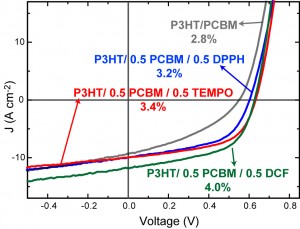Ternary Mixtures for Improved Performance in P3HT/PCBM Bulk Heterojunction Solar Cells
- Category: Energy, Materials
- Tags: Trisha Andrew, Vladimir Bulovic
Photovoltaic cells containing nanoscale phase separated mixtures of a poly(thiophene) donor and a fullerene acceptor in the active layer have proven to be a attractive class of low-cost solar energy harvesting devices. The benchmark polymer solar cell (PSC) is one fabricated with poly(3-hexylthiophene) (P3HT) and PCnBM (n = 61, 71, Figure 1), which displays power conversion efficiencies of approximately 5% [1] . Extensive optimization of the polymeric donor component has lead to the evolution of PSCs with power conversion efficiencies of approximately 8% [2] ; however, soluble fullerene derivatives remain the primary choice for the donor component in bulk heterojunctions. We have demonstrated that select small-molecule acceptors can serve as fullerene substitutes in P3HT/PC61BM bulk heterojunctions and can increase the power conversion efficiencies of the resulting solar cells (Figure 2). Ternary mixtures containing 6,6-dicyanofulvenes [3] , such as DCF (Figure 1), yield average power conversion efficiencies of 4%. Moreover, ternary mixtures containing stable organic radicals, such as TEMPO and DPPH, also augment the performance of P3HT–PC61BM solar cells and result in power conversion efficiencies of up to 3.4%.
- Figure 1: Structures of PC61BM, a soluble fullerene acceptor, and three substitutes for fullerene-based acceptors in polymer solar cells.
- Figure 2: J-V characteristics of photovoltaic cells fabricated with ternary mixtures containing P3HT; 50 wt% PC61BM; and 50 wt% of either DCF, TEMPO, or DPPH.
- G. Dennler, M. C. Scharber, and C. J. Brabec, “Polymer-Fullerene Bulk-Heterojunction Solar Cells” Adv. Mater., vol. 21, pp. 1323-1338, Nov. 2009. [↩]
- H.-Y. Chen, J. Hou, S. Zhang, Y. Liang, G. Yang, Y. Yang, L. Yu, Y. Wu, and G. Li, “Polymer solar cells with enhanced open-circuit voltage and efficiency” Nature Photon., vol. 3, pp. 649-653, June 2009. [↩]
- T. L. Andrew, J. R. Cox, and T. M. Swager, “Synthesis, Reactivity, and Electronic Properties of 6,6-Dicyanofulvenes” Org. Lett. vol 12, pp. 5302-5305, Sept. 2010. [↩]

